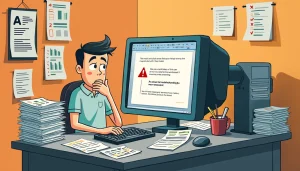Last Updated: October 9, 2024
If you’re a frequent user of Microsoft Word, you’ve probably encountered the frustrating issue of grayed out options. These options can prevent you from accessing important features and tools, hindering your productivity and workflow. Understanding why certain features are grayed out is essential for effective document editing.
In this article, we will dive deep into the common causes of this problem, such as document restrictions and compatibility mode. We’ll also discuss how these grayed out options can negatively impact your user experience.
But don’t worry! We won’t leave you hanging. We’ll provide you with a detailed troubleshooting guide that will help you quickly resolve the issue. You’ll learn how to check document protection settings and disable compatibility mode, along with some additional tips and tricks to keep your Microsoft Word running smoothly. Whether you are drafting a paper for school or preparing a professional report, you’ll want to make sure your options are fully available. Keep reading to discover effective solutions for dealing with Microsoft word grayed out options!
Table Of Contents
Understanding Microsoft Word Grayed Out Options
Common Causes of Grayed Out Features
Many users stumble upon the frustration of Microsoft word grayed out options. When certain features are grayed out, it means they can’t be used. Here are some common causes that may lead to this issue:
1. Document Restrictions and Editing Permissions
– Protected Documents: If a document is password-protected, this may restrict editing features. You can only make changes if you have the correct password.
– Restricted Editing Mode: Sometimes, a document may have restrictions applied to it, allowing only specific edits. This mode is typically used to prevent changes in sensitive documents.
– Shared Documents: When collaborating on a document through OneDrive or SharePoint, permissions can get tricky. A document might be set to view-only, which prevents modifications.
You can go to the Review tab and click on Restrict Editing to check for restrictions. This will display the current settings and allow you to see if permissions limit you.
2. Compatibility Mode and Features Limitations
– Different File Formats: If you are working with older versions of Word documents (like .doc instead of .docx), you may find that some features are unavailable. Compatibility mode keeps the file readable for older applications but restricts some newer capabilities.
– Mixed Contents: Documents that include elements from different versions of Word might cause features to gray out. For instance, if an old .doc file includes new features, those features can become inaccessible.
To check if you’re in compatibility mode:
1. Look at the title bar of the document. If it mentions Compatibility Mode, this is likely your problem.
2. Convert the file to the latest version by going to File > Info > Convert.
Impact on User Experience and Document Editing
Discovering Microsoft Word grayed out options can seriously disrupt workflow. When features are inaccessible, users may feel frustrated because they cannot perform essential actions needed for document editing. Here are some specific impacts:
– Reduced Productivity: Time is wasted trying to figure out why certain features aren’t working. Instead of focusing on writing or editing, users may spend unnecessary energy troubleshooting.
– Limited Collaboration: Users collaborating in a shared document may miss out on valuable features like comments or track changes if their permissions are not aligned correctly.
– Increased Errors: If users do not realize they are in a limited editing mode, they might make changes that are not allowed, leading to potential errors and confusion later.
Understanding these causes and impacts helps users troubleshoot issues effectively. Whether you encounter restrictions due to document permissions or compatibility features, recognizing these factors paves the way for a smoother editing experience.
Now that we better understand the reasons behind grayed out options, we can begin exploring solutions. Next, we will outline practical steps for fixing these issues, ensuring you can edit your documents without barriers.
Solutions for Fixing Grayed Out Options in Microsoft Word
Step-by-Step Troubleshooting Guide
When you encounter Microsoft Word grayed out options, it can be frustrating, especially if you’re in the middle of an important task. Fortunately, there are ways to resolve this issue! Below, we provide a step-by-step guide to help you troubleshoot and fix the grayed-out options in Microsoft Word.
1. Checking Document Protection Settings
One of the first things to check when you notice that options are grayed out is the document protection settings. Here’s how to do this:
- Open your Word document.
- Go to the Review tab in the ribbon.
- Look for the Restrict Editing option.
- If the option shows that editing is restricted, click on it.
- You may see a message about editing restrictions. If you have the password, enter it; otherwise, you may need to contact the document creator.
This should restore your access to features that were previously unavailable. If the options still remain grayed out, proceed to the next step.
2. Disabling Compatibility Mode
Another reason why you might see Microsoft word grayed out options is that the document is in compatibility mode. This often happens when a document is created in an older version of Word. To disable compatibility mode, follow these steps:
- Open the document in Microsoft Word.
- Go to the File menu.
- Select Info from the sidebar.
- Look for a button that says Convert. This will upgrade the document to the latest format.
- Click Convert and then save the document.
After completing these steps, your options should become available again. If the issue persists, try the additional tips below.
Additional Tips and Tricks
If you’ve already tried the above troubleshooting steps and still encounter Microsoft Word grayed out options, here are a couple more tips that might help you resolve the issue.
1. Updating Microsoft Word
Outdated software can often lead to errors or limitations. Make sure you are running the latest version of Microsoft Word, as updates often fix bugs and improve functionality. Here’s how to update Microsoft Word:
- Open Microsoft Word.
- Click on File.
- Choose Account from the list.
- Click on the Update Options button.
- Select Update Now to check for the latest updates.
Once the updates are installed, restart Word and check if the options have returned.
2. Restarting the Application and Your Computer
Sometimes, a simple restart can do wonders! It clears temporary glitches that might be causing issues. Here’s how to restart:
- Save any open files and close Microsoft Word.
- Restart your computer to refresh the system.
- Once your PC has restarted, open Microsoft Word again.
- Reopen the problematic document and check for the grayed-out options.
This straightforward step can significantly improve the performance of Microsoft Word and fix minor glitches.
Summary of Steps
To recap on fixing Microsoft Word grayed out options, here is a summary table of the steps mentioned above:
| Step | Action | Instructions |
|---|---|---|
| 1 | Check Document Protection | Go to Review > Restrict Editing |
| 2 | Disable Compatibility Mode | File > Info > Convert |
| 3 | Update Microsoft Word | File > Account > Update Options |
| 4 | Restart Application | Close Word and restart your computer |
Implementing the above solutions offers hope when you face the frustration of microsoft word grayed out options. Whether it’s checking document protection or disabling compatibility mode, each step is essential for getting back to your work efficiently. If problems persist, consider visiting Microsoft Support for more detailed assistance.
Wrap Up
Dealing with the issue of Microsoft Word grayed out options can be frustrating, especially when you’re working on an important document. Understanding the common causes behind these grayed out features is crucial in effectively troubleshooting the problem. Whether it’s due to document restrictions, editing permissions, or simply being in compatibility mode, recognizing these issues is the first step to regaining full access to the editing tools you need.
We provided a detailed step-by-step troubleshooting guide that highlights how to check document protection settings and disable compatibility mode, enabling you to swiftly navigate your way back to a fully functional Microsoft Word environment. Additionally, remember that sometimes simple actions like updating the application or restarting your computer can refresh and resolve underlying issues.





